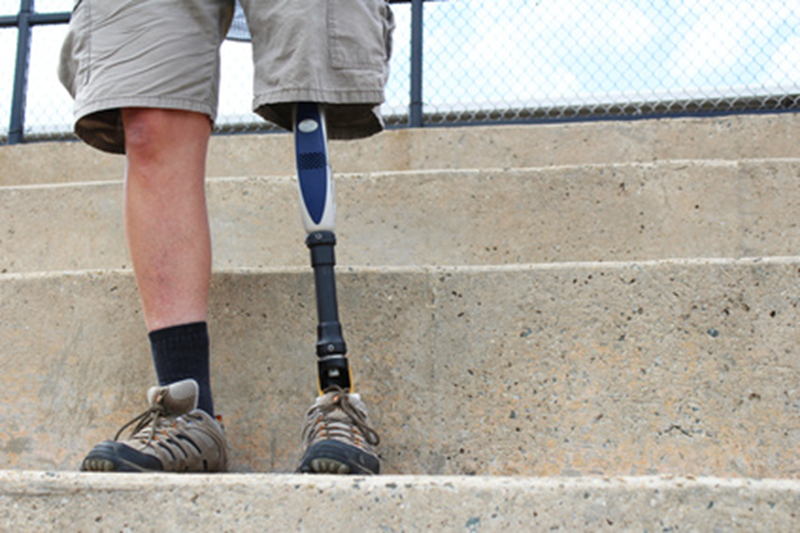Life After Amputation
Amputation is one of the oldest known surgical treatments, with records of the operation dating back to ancient times. An amputation is performed in cases when an injured or diseased limb is not expected to heal, and the patient's life is endangered as a result. By the fifteenth century, surgeons had begun perfecting the technique, which often saved a warrior’s life. It’s estimated that approximately 200,000 people in Canada are living with an amputation of one kind or another. Although many limb amputations are a result of diabetes, cancer, or other diseases, a large percentage are traumatic amputations caused by industrial accidents, domestic mishaps, or motor vehicle collisions. (And, as in ancient times, battlefield injuries also sometimes lead to amputation.) If you have recently had to have a limb amputated, take heart. Today’s prosthetics are lighter and more effective than ever before, and there are several support groups in Canada that can help you to live your life to the fullest.
Many amputees go through a rough period immediately following their surgery. Some experience depression, isolation, and loss of self-esteem; however, with time and good medical care, most issues can be resolved. Counselors can help the amputee to deal with the emotions that accompany such a radical change. The first step on the road to healing is to deal with the physical pain of the amputation site. Patients will need both medication and rest. One of the most persistent problems is “phantom pain,” which affects a certain percentage of new amputees. They may feel pain or a deep itchiness in the place where the limb used to be. Fortunately, today’s pain medication can alleviate phantom pain in almost all patients.
Next, the wound at the amputation site has to heal. Usually, the wound closes and forms a scar within the first month after surgery. However, it actually takes more than a year before the wound will be completely healed, inside and out. The amputee needs to learn how to care properly for the residual limb, with bandages, compression therapy, and medications as recommended by his/her doctor. For some amputees, an interim prosthetic may be fitted as early as ten days after surgery, and first exercises can begin. However, before you can wear a prosthesis, your residual limb should be adequately healed, and all excess fluid drained. The shape of the limb will then be evident, and your prosthesis can be made.
Prosthetics
While the incision is healing, a prosthetist will be crafting a prosthesis. These are uniquely made for each amputee, based on interviews about his/her lifestyle, and on molds made from casts of the residual limb. It’s important to choose the right components for the permanent device, as the more closely the prosthesis meets the needs of the patient, the more successful rehabilitation will be.

Once a prosthesis is introduced and fitted exactly, patients with a lower limb amputation will begin by learning how to put a bit of weight on the residual limb. The device will help to restore the amputee’s mobility and help him/her to avoid posture and balance problems; it will also help to avoid wear and tear on the remaining limb. Patients with an upper limb amputation will begin learning how to manipulate a prosthesis effectively, and/or to use a different hand to write and eat. Targeted therapy during rehabilitation training will teach the amputee how to gain as much independence and proficiency with the prosthesis as possible. In addition, patients learn how to care properly for the residual limb, and how to maintain the prosthetic limb.
Support
Following an amputation, patients may need various types of support. These may include:
- Continuing Medical Support. In order to help resolve any medical problems arising from the surgery, to monitor progress, and to promote health.
- Individual Counseling. In order to deal with any feelings of depression or body image problems.
- Family Counseling. In order to ensure that family relationships are not stressed unnecessarily, and that all family members understand the realities and challenges of living with an amputation.
- Continuing Rehabilitation Support. Working with a physiotherapist and an occupational therapist on an ongoing basis is crucial in order for the amputee to realize his/her full potential.
- Group Support. In Canada, there are several excellent organizations that understand the needs of amputees. These include The War Amps (not only for combat veterans), the Amputee Coalition, Amputees Amplified, My Left Shoe, as well as organizations dedicated to sports and leisure activities designed especially for amputees. A list of resources can be found at Amputee.ca
- Lawyer. In the case of a traumatic amputation arising from an accident, finding a good personal injury lawyer is imperative. An experienced personal injury lawyer will understand what steps are necessary in order to file a successful insurance claim or a tort case. Some personal injury law firms even have lawyers who work only on cases involving amputations. Financial support is crucial to amputees, who may miss time at work, or even need to switch careers.
Life after amputation doesn’t have to be difficult. If you have recently undergone an amputation, know that there are many amputees in Canada who understand your struggle, and many others who will be there to support you on your journey to recovery.